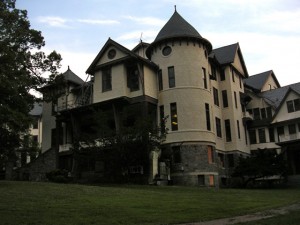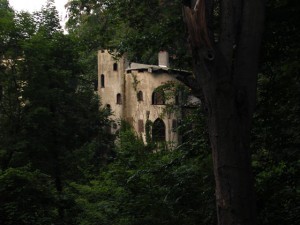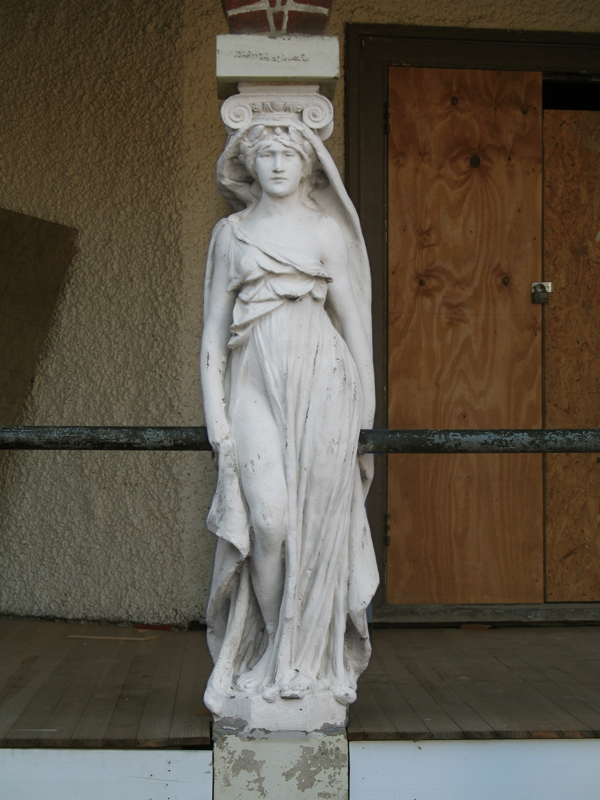Hidden among a leafy scattering of houses and trees, Forest Glen Seminary is a jumble of vernacular buildings unlike any of the temples of boxes that define Washington. Its buildings, both magnificent and ludicrous amount to a dignified campiness that defies expectations to be one of the most profoundly interesting places encircled by the Beltway. Once constituting a women’s college when that meant a two-year Mrs. degree, the buildings are once again becoming domestic space, the more private areas cut into condos and the core of the complex, rental units. Scattered around the area, turn-of-the-century houses are being renovated and new housing by the urbanist developer EYA has just been finished. Through the site’s history, radical changes have shaped its form, but none so radical as the current shift in context.

Forest Glen Seminary educated middle-class daughters from 1894 until 1937 in what was originally a Tudor resort along the B&O Railroad called Ye Forest Inn that itself had catered to vacationers unable to afford a trip to fancier digs. While the girl’s school found more financial success than the inn, the crushing economic problems of the Great Depression made pricy educations meant to keep someone out of the workforce unpopular, it too began to lose money. A junior business college managed to last for a few years in its place, until the property was unceremoniously seized in 1941 under the War Powers Act.
The Army quickly made use of it as an annex of Walter Reed. Soldiers rehabilitating from wounds would stay at the campus until they were fit for combat or to return home. Army architects went to work modifying the building so patients, many of whom were not ambulatory, could comfortably recuperate. As medicine changed and the war ended, the mission of the site became one of research, necessitating more drastic interior and infrastructural changes. Nonetheless, the buildings survived the period well enough, losing the Odeon and gaining an ugly stair tower in the process. By the 1970s, however, the main building was falling apart and the Beltway had been carved through the gardens to the north.
Seeing no other future in the dilapidated ensemble, the Army attempted to demolish the buildings and replace them with purpose-built structures, leading to local opposition and eventually, landmark status. Frustrated and apathetic, the Army simply gave up on the rotting campus and abandoned it. Fortunately, the local group, Save Our Seminary, was able to consolidate passing interest in the buildings, guaranteeing that they survived until someone would come along and fix them up. In the meantime, the strange relics seemed to pop out of the back roads, transporting lost drivers to a slasher film for a moment before suddenly returning them to an ordinary subdivision.

At face, the old campus is a lively jumble of naïve kitsch and kitschier pretensions. Greek colonnades blithely abut the tudor walls of the main building, both standing opposite a windmill and an Italianate villa. The inventory gets stranger: A gothic chapel, a pagoda, a five-story ballroom, an alpine chalet, mission-style servants’ quarters and workshops, a classical theater, a bungalow inexplicably named the “Aloha House,” a castle with a drawbridge, a colonial mansion and an “indian mission” stand scattered around the grounds. In between each of these structures, a network of enclosed, elevated, interconnected walkways snake around, creating passages and portals of such complexity they would make John Hejduk proud.
Anyone examining the campus without knowledge of its history will find it mysterious in the complexity of its apparently nonsensical elements, like an arcane puzzle. Although the styles of most buildings are familiar and comfortable, the deeper elements of function and typology are vastly different in form. Mental rules that let you avoid analysis, like doorway in front, give way to a shock that interrupts one’s thoughts and demands further explanation. Call this childlike: one must abandon gravity and approach the problems with a joyful compulsion: real curiosity.
One can spend hours disassembling and parsing the unusual parts or probing the innumerable nooks. The architectural depth of each structure leads to further elements of fascination, interesting either as manifestations of a larger system or because they are their own little curios. One conundrum leads a visitor to an oddity and then to a tiny sliver of sublimity, no matter how insignificant they are, the sheer number of strange things offers virtually endless prompts to try and comprehend the decisions that manifested the building.

Rather than resolving into some prosaic explanation (the building is a joke, etc.), the purpose of the building is tailored to a highly specific purpose, unified with a particular aesthetic and ideology. It does not affect some kind of mystery, rather, the wood and mortar inherited that from the educational program. For example, the follies were sorority houses; unique themes were seen as a fun way of adding what, in an era of Fu Manchu and American Renaissance, counted as a cosmopolitan atmosphere. The tunnels were designed so the delicate students could pass from buildings to building, unencumbered raincoats as much as rain. Every aspect of the building would add another aspect of civilization to the girls’ daily lives.
The school’s head, John Cassedy, insisted on filling the lives of students with culture. He attempted to do so by scattering Grecian statuary all around the campus, from the train station to the athletic fields, and in between. There are a number of Greek women, including Athena, a handful of vases, an impressive fountain, and a yellow wooden statue of an Indian probably named Shamed-by-Own-Racism. Supporting the portico around the Aloha House, stand a set of identical, very American karyatids. This reproduced woman embodies the school in a way: Well poised and dressed, she effortlessly balances an ionic capital on her head, as though forever practicing her posture.
All of the buildings are the result of the process of creating a campus for people of a mindset lost to time. You and I are unlikely to ever understand their views without dedicating yourself to anthropology of a markedly different civilization. Even then, you are unlikely to ever really empathize with any of the deep pretensions or their underlying values in such a way that you would want to build anything like Forest Glen Seminary. The building evokes an inscrutable past.
So whom do the new buildings evoke? The paranoid, driven parents who desperately cling to their gestalt idea of home, a shrink-wrapped ersatz traditional place that their kids can be safe from everything and similarly walk to everything (except that which makes them independent). The place gives me a distinct sense of unease, affirming that the most compelling fruits of the zeitgeist are completely unintentional.
This website contains excellent resources. More photographs of the old buildings are available at my Flickr account. The site doesn’t lend itself to photographs, you just might want to visit.
Part 2: One Thing Leads to Another;
Part 3: An Unintentional Project;
Part 4: Back to the City

In the process of buying one of the “follies” at NPS (the Alpha Bungalow, which is probably the least folly of the bunch) and came upon your blog in a Google search. Gotta agree with you on the ugliness of the new-builds along Linden. But what about looking at them as a modern-day version of what the Seminary’s president was going for back in the day? The Columbian Exposition architecture books gave NPS buildings from all different cultures (supposedly), then why not American suburbia?
I couldn’t agree more in the lack of walkability in the neighborhood, but I’ll posit this: my family has lived in Petworth for 7 years now, but we still have to drive to everything (except work, which I do and still will commute to via Metro). The Petworth Safeway is terrible, but drive 10 minutes and you get to the Piney Branch one: much nicer (albeit not the Social Safeway or the Wegman’s I knew growing up in WNY). The local dive restaurants are okay, but why settle for cramped local mexican or needlessly haughty Domku when you can drive 10 minutes to Adams Morgan? Heck, even the fast food is better elsewhere– our Wendy’s is perennially dirty, and the Pizza Hut puts you on hold for 10 minutes at a time, but you can easily drive to a brand-new McDonald’s and a Domino’s with great service in the same amount of time. So if I’m moving my family away from a walkable neighborhood into suburbia, I’m truly disappointed in myself, but I don’t see my walkable neighborhood as being particularly walkable in the first place.
(And since your blog’s about architecture, I won’t even go into the difference in schools for my kids…)